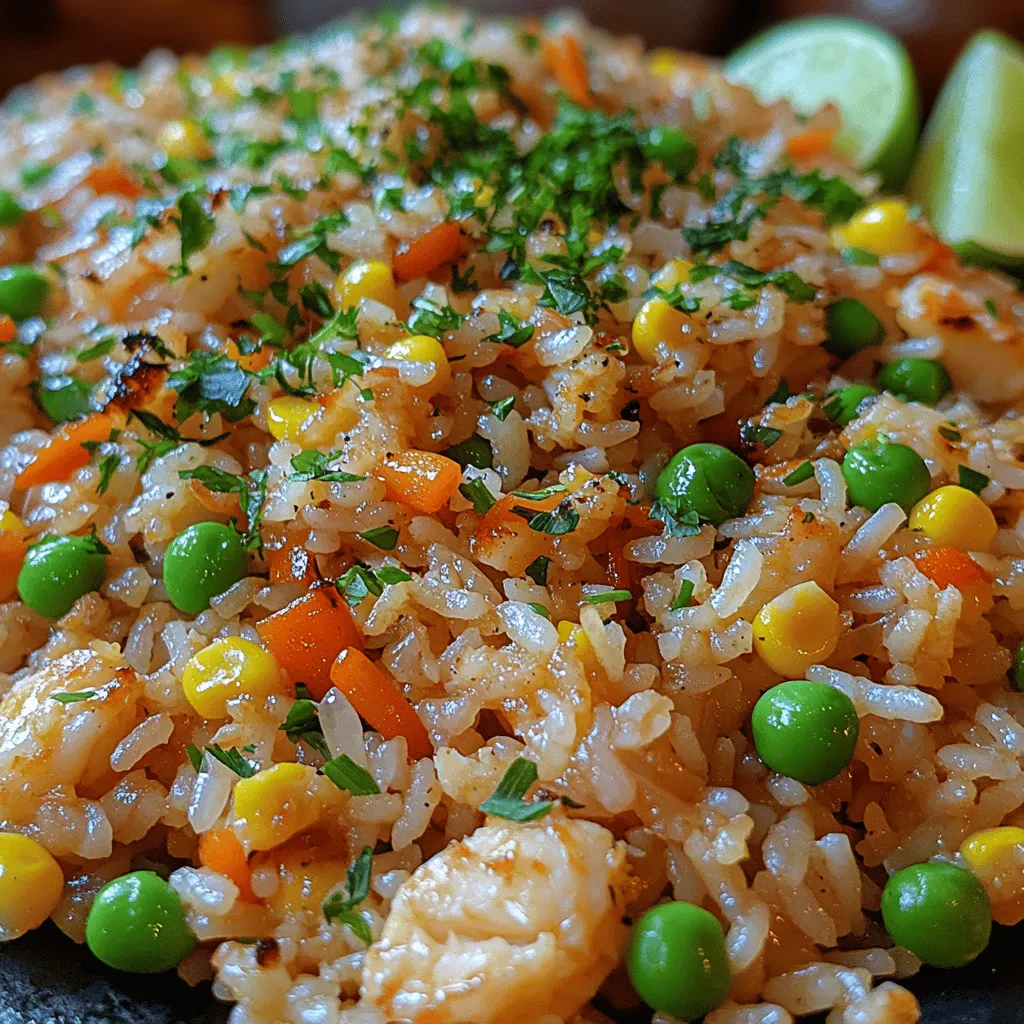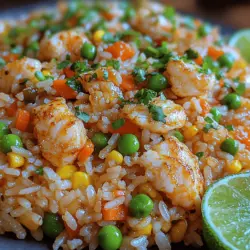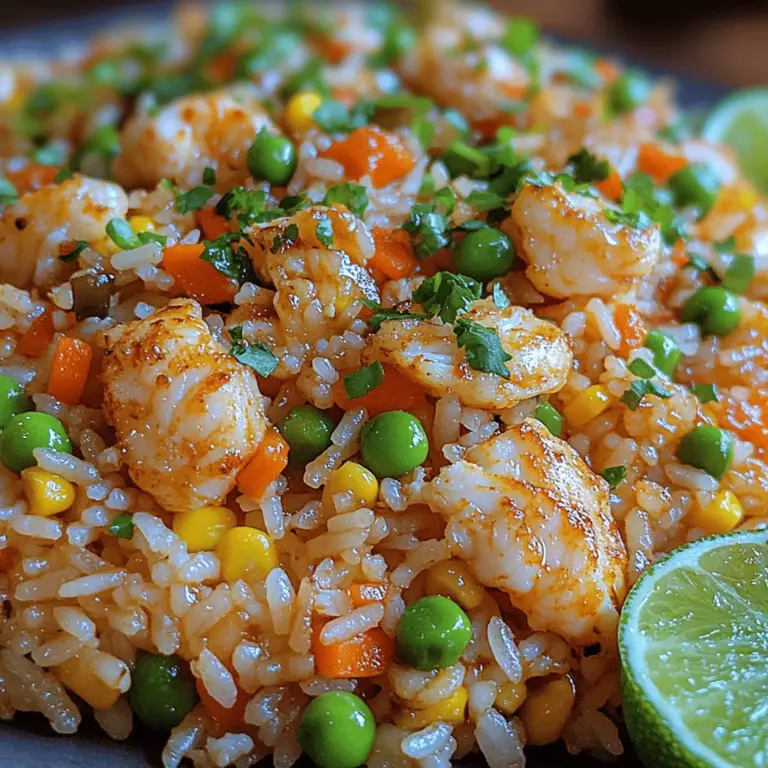Introduction to Thai Style Crab Fried Rice
Thai Style Crab Fried Rice is a beloved dish that embodies the vibrant flavors and aromatic essence of Thai cuisine. Known as “Khao Pad Poo” in Thai, this delectable fried rice preparation showcases the delicate sweetness of lump crab meat, harmonizing beautifully with the fragrant jasmine rice and a medley of colorful vegetables. This dish not only stands out for its taste but also for its visual appeal, making it a popular choice in Thai restaurants and home kitchens alike.
The allure of Thai Style Crab Fried Rice lies in its simplicity and the quality of its ingredients. Fresh crab meat is the star of the dish, bringing a succulent and sweet flavor that elevates the entire meal. The combination of jasmine rice, sautéed vegetables, and a careful balance of sauces creates a symphony of flavors that excite the palate and leave diners craving more. With its roots in Thailand, this dish is often found in street food stalls and fine dining establishments, reflecting its versatility and widespread popularity.
To achieve an authentic taste, using fresh, high-quality ingredients is paramount. The freshness of the crab meat, the aromatic nature of the garlic, and the zest of lime juice all contribute to the dish’s signature profile. In this article, we will explore the core ingredients, their significance, and provide a step-by-step preparation guide to help you recreate this delightful dish in your own kitchen.
Understanding the Core Ingredients
Jasmine Rice
At the heart of any fried rice dish is the rice itself, and for Thai Style Crab Fried Rice, jasmine rice is the preferred choice. This long-grain rice is known for its fragrant aroma and slightly sticky texture, which allows it to clump together while still remaining fluffy. Jasmine rice absorbs flavors exceptionally well, making it an ideal base for the bold and savory components of the dish.
When preparing the rice, it’s essential to cook it ahead of time and allow it to cool, preferably in the refrigerator. Chilled rice is crucial as it prevents clumping during the frying process, ensuring that each grain remains separate and perfectly textured.
Lump Crab Meat
The highlight of this dish is undoubtedly the lump crab meat, which can be either fresh or canned. Fresh crab meat offers a sweeter and more delicate flavor, while canned crab meat provides convenience and is often more accessible. When selecting crab meat, look for high-quality options that are sourced sustainably. Fresh lump crab meat should be sweet, moist, and tender, with a clean oceanic aroma.
Incorporating crab meat into the fried rice not only enhances the dish’s flavor but also adds a luxurious touch, making it suitable for special occasions or a comforting family meal.
Aromatics
Aromatics play a crucial role in Thai cooking, and for this fried rice recipe, garlic and onion are essential. Garlic imparts a fragrant, slightly spicy note, while onion adds sweetness and depth. When sautéed together, they create a flavorful foundation that enhances the overall taste of the dish.
To maximize the flavor, finely chop the garlic and onion before cooking, allowing their essential oils to release fully during the sautéing process. This step is vital for building the aromatic base that is characteristic of Thai cuisine.
Mixed Vegetables
Incorporating mixed vegetables not only adds color and nutrition to the dish but also contributes to its overall texture. Common choices for Thai Style Crab Fried Rice include diced carrots, peas, and corn. Carrots provide a subtle sweetness and crunch, while peas and corn add pops of color and flavor.
When selecting vegetables, opt for fresh, vibrant produce. You can also experiment with other vegetables such as bell peppers, baby corn, or green onions, depending on your preferences and what you have on hand.
Sauces and Seasonings
The balance of flavors in Thai Style Crab Fried Rice is achieved through a careful blend of sauces and seasonings. Key components include fish sauce, oyster sauce, soy sauce, lime juice, and a touch of sugar.
– Fish sauce adds a salty umami flavor, which is a hallmark of Thai cuisine.
– Oyster sauce contributes a rich, slightly sweet depth.
– Soy sauce brings complexity, while lime juice adds brightness and acidity, balancing the dish beautifully.
– A sprinkle of sugar helps to enhance the natural sweetness of the crab and vegetables.
The combination of these ingredients creates a symphony of flavors that is both satisfying and refreshing.
Step-by-Step Preparation Guide
Preparing the Rice
The first step in making the perfect Thai Style Crab Fried Rice is preparing the jasmine rice. Begin by rinsing the rice under cold water until the water runs clear, which removes excess starch and helps prevent it from becoming gummy during cooking. Next, cook the rice according to package instructions, allowing it to cool completely before using. For the best results, refrigerate the cooked rice for a few hours or overnight. This chilling process helps the rice firm up, making it easier to stir-fry without sticking.
Heating the Oil
Choosing the right oil is crucial for frying rice. A high smoke point oil, such as vegetable oil or peanut oil, is ideal for stir-frying as it can withstand high temperatures. Heat the oil in a large skillet or wok over medium-high heat until it shimmers. This ensures a good sear on the ingredients, enhancing their flavors.
Sautéing the Aromatics
Once the oil is hot, add the finely chopped garlic and onion. Sauté them for about 30 seconds to 1 minute, or until they become fragrant and the onion is translucent. Be careful not to let them brown too much, as this can impart a bitter flavor. The goal is to create a fragrant base that will infuse the rice with flavor.
Cooking the Eggs
Next, push the sautéed aromatics to one side of the pan and crack two eggs into the empty space. Scramble the eggs gently, allowing them to cook through before breaking them up into smaller pieces. Once the eggs are cooked, mix them with the aromatics. This technique ensures that the eggs are fully integrated into the fried rice and adds richness to the dish.
Adding Vegetables
With the eggs cooked, it’s time to add the mixed vegetables. If using fresh vegetables, sauté them for about 2-3 minutes, or until they are tender but still crisp. If using frozen vegetables, they may need an extra minute or two to heat through completely. This step adds color and nutrition to the dish while ensuring that the vegetables remain vibrant and flavorful.
Combining Ingredients
Once the vegetables are tender, add the chilled jasmine rice to the pan. Use a spatula to break up any clumps and ensure an even distribution of all ingredients. Stir-frying the rice with the aromatics, eggs, and vegetables allows the flavors to meld together beautifully.
Flavoring the Rice
To flavor the rice, drizzle in the fish sauce, oyster sauce, soy sauce, and a squeeze of fresh lime juice. Start with smaller amounts and adjust to taste, allowing the rice to absorb the flavors as you stir-fry. A touch of sugar can also be added at this stage to balance the flavors. Continue to stir-fry for an additional 2-3 minutes, ensuring that the sauces are evenly distributed and the rice is heated through.
Through these detailed steps, you will create an authentic and flavorful Thai Style Crab Fried Rice that is sure to impress your family and friends. Stay tuned for the next part, where we will explore additional tips for achieving the best results and answer some common questions related to this delightful dish.

Adding Crab Meat: Techniques for Preserving the Crab’s Texture
When it comes to preparing Thai Style Crab Fried Rice, the technique used to add crab meat is crucial for maintaining its delicate texture and enhancing the overall dish. Begin by selecting fresh crab meat—preferably lump or backfin crab, which has larger pieces that hold their shape well during cooking.
1. Preparation: If using fresh crab, ensure that it is cooked and cooled before use. Gently pick through the crab meat to remove any shells or cartilage. If you’re using canned crab meat, drain it thoroughly to avoid excess moisture, which can make the fried rice soggy.
2. Timing: The key to preserving the crab’s texture lies in when you add it to the pan. After stir-frying your vegetables and rice, create a well in the center of the pan. Add the crab meat at this stage and gently fold it into the hot rice. This method allows the crab to warm through without overcooking, ensuring that it retains its tender, flaky quality.
3. Gentle Mixing: When combining the crab with the rice, use a spatula to fold the ingredients together rather than stirring vigorously. This helps keep the crab meat intact and prevents it from breaking into smaller pieces, which can lead to a mushy texture.
Finishing Touches: The Role of Green Onions and Garnishing
The finishing touches are where Thai Style Crab Fried Rice transforms into a visually stunning and flavorful dish. The inclusion of green onions and garnishes plays a significant role in enhancing both visual appeal and taste.
1. Green Onions: After adding the crab, sprinkle chopped green onions over the rice. The green onions not only add a pop of color but also provide a mild onion flavor that complements the sweetness of the crab. Add a small amount of white parts during cooking for a subtle flavor, and reserve the green tops for garnish.
2. Garnishing: Consider garnishing your dish with fresh herbs such as cilantro or Thai basil. These herbs not only add freshness but also enhance the dish’s aromatic profile. A wedge of lime on the side is also a must, as the acidity brightens the flavors and balances the richness of the crab and rice.
Flavor Profile of Thai Style Crab Fried Rice
Understanding the flavor profile of Thai Style Crab Fried Rice is essential for appreciating its complexity. This dish is a harmonious blend of umami, sweetness, and acidity, showcasing the versatility of Thai ingredients.
1. Umami: The crab meat contributes a rich umami flavor, which is further enhanced by the addition of soy sauce and oyster sauce. These sauces provide depth and a savory backbone to the dish.
2. Sweetness: The use of ingredients like eggs and the natural sweetness of crab balances out the savory elements. Additionally, if you choose to add vegetables, such as peas or carrots, they can introduce a slight sweetness, adding to the overall flavor complexity.
3. Acidity: The freshness of lime juice and the contrast of herbs add a bright acidity that cuts through the richness of the crab and rice. This balance is what makes Thai cuisine so appealing, as it engages various taste sensations.
4. Herbs and Garnishes: Fresh herbs elevate the dish, with their aromatic qualities contributing additional layers of flavor. The inclusion of cilantro and green onions not only enhances the dish’s taste but also adds freshness, making every bite enjoyable.
5. Comparison to Other Fried Rice Dishes: Unlike other fried rice varieties, which may lean heavily on soy sauce or meat, Thai Style Crab Fried Rice stands out with its seafood base and a delicate balance of flavors. This showcases the unique approach of Thai cuisine, which often harmonizes salty, sweet, and sour notes.
Nutritional Benefits of the Ingredients
Thai Style Crab Fried Rice is not only delicious but also packed with nutrients, making it a balanced meal option.
1. Health Benefits Associated with Crab Meat: Crab meat is a lean protein that is low in fat and high in essential nutrients. It’s a good source of omega-3 fatty acids, which are known to promote heart health, and is rich in vitamins and minerals, including vitamin B12, selenium, and zinc. These nutrients contribute to overall health, supporting immune function and energy production.
2. Nutritional Value of Jasmine Rice Compared to Other Rice Varieties: Jasmine rice, a staple in Thai cuisine, has a fragrant aroma and a slightly sticky texture. It is a good source of carbohydrates, providing energy, and contains essential nutrients such as manganese, magnesium, and small amounts of B vitamins. Compared to other rice varieties, jasmine rice has a higher glycemic index; however, when paired with protein and vegetables, it can fit into a balanced diet.
3. Advantages of Incorporating Mixed Vegetables in Meals: Adding mixed vegetables to your fried rice not only boosts the nutritional value but also enhances the texture and flavor. Vegetables like bell peppers, peas, and carrots provide fiber, vitamins, and minerals, making the dish more filling and promoting digestive health. Including a variety of colors in your vegetables also ensures a broader range of nutrients.
4. How the Dish Fits into a Balanced Diet: When served with a side of vegetables or a fresh salad, Thai Style Crab Fried Rice can be part of a balanced meal. The combination of protein from crab, carbohydrates from rice, and fiber from vegetables makes it a satisfying option that can be enjoyed without guilt.
Serving Suggestions and Pairings
Thai Style Crab Fried Rice is versatile and can be served in various ways to complement its unique flavors.
1. Ideal Accompaniments: For a complete meal, consider serving your crab fried rice with a side of fresh vegetable spring rolls or a light Thai salad. The crispness and freshness of these sides provide a nice contrast to the rich flavors of the fried rice.
2. Beverage Pairings: To enhance your dining experience, pair your dish with a refreshing beverage. A light Thai iced tea can offer a sweet contrast, while a crisp lager or a chilled white wine, such as Sauvignon Blanc, complements the dish beautifully. For a non-alcoholic option, a sparkling water with lime can cleanse the palate.
3. Presentation Tips: Presentation plays a crucial role in making your dish appealing. Serve the crab fried rice in a shallow bowl or plate, garnished with additional herbs and lime wedges. You can also create a visually striking plate by arranging the crab fried rice in a ring mold, topped with fresh herbs and a sprinkle of sesame seeds for added texture.
Conclusion: Embracing Thai Cuisine at Home
Thai Style Crab Fried Rice is a delightful dish that captures the essence of Thai cuisine, combining fresh ingredients and vibrant flavors. Its versatility makes it a great option for home cooks looking to explore the richness of Thai flavors.
This dish not only showcases the unique taste of crab but also allows for creativity with vegetables and seasonings. Whether you’re preparing it for a weeknight dinner or a special occasion, this recipe is sure to impress.
By trying your hand at making Thai Style Crab Fried Rice, you embark on a culinary journey that embraces the art of Thai cooking. The joy of exploring these flavors and techniques can inspire you to continue experimenting in the kitchen, creating delicious meals that bring the taste of Thailand to your home. So gather your ingredients, follow the steps, and indulge in the delightful experience of crafting this exquisite dish.

